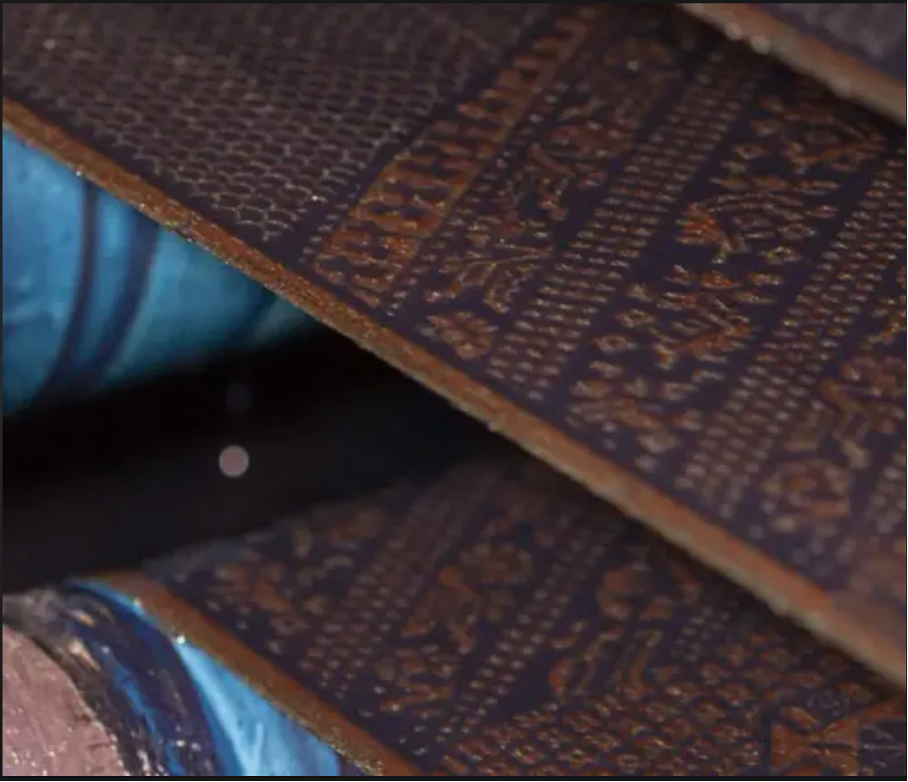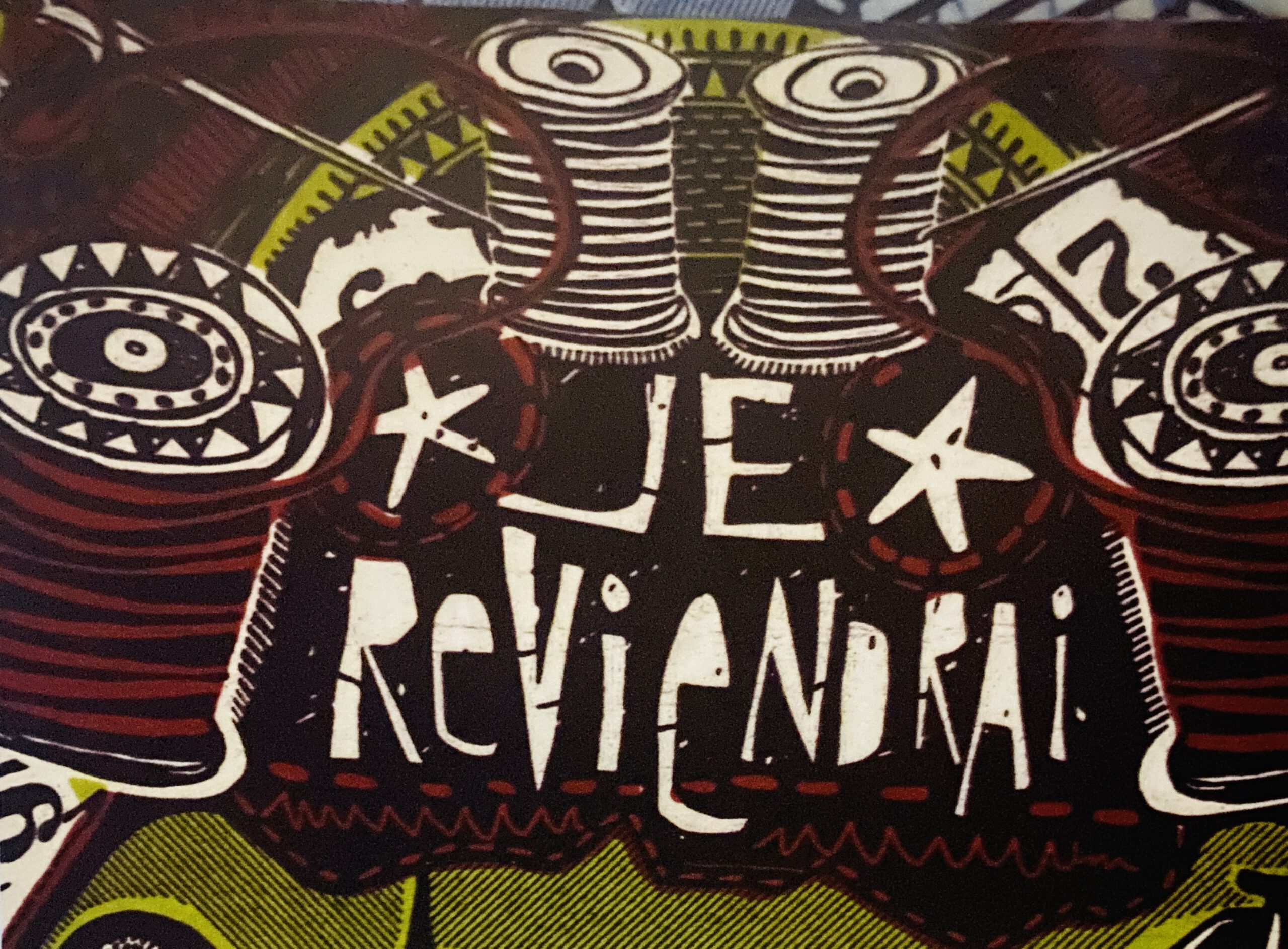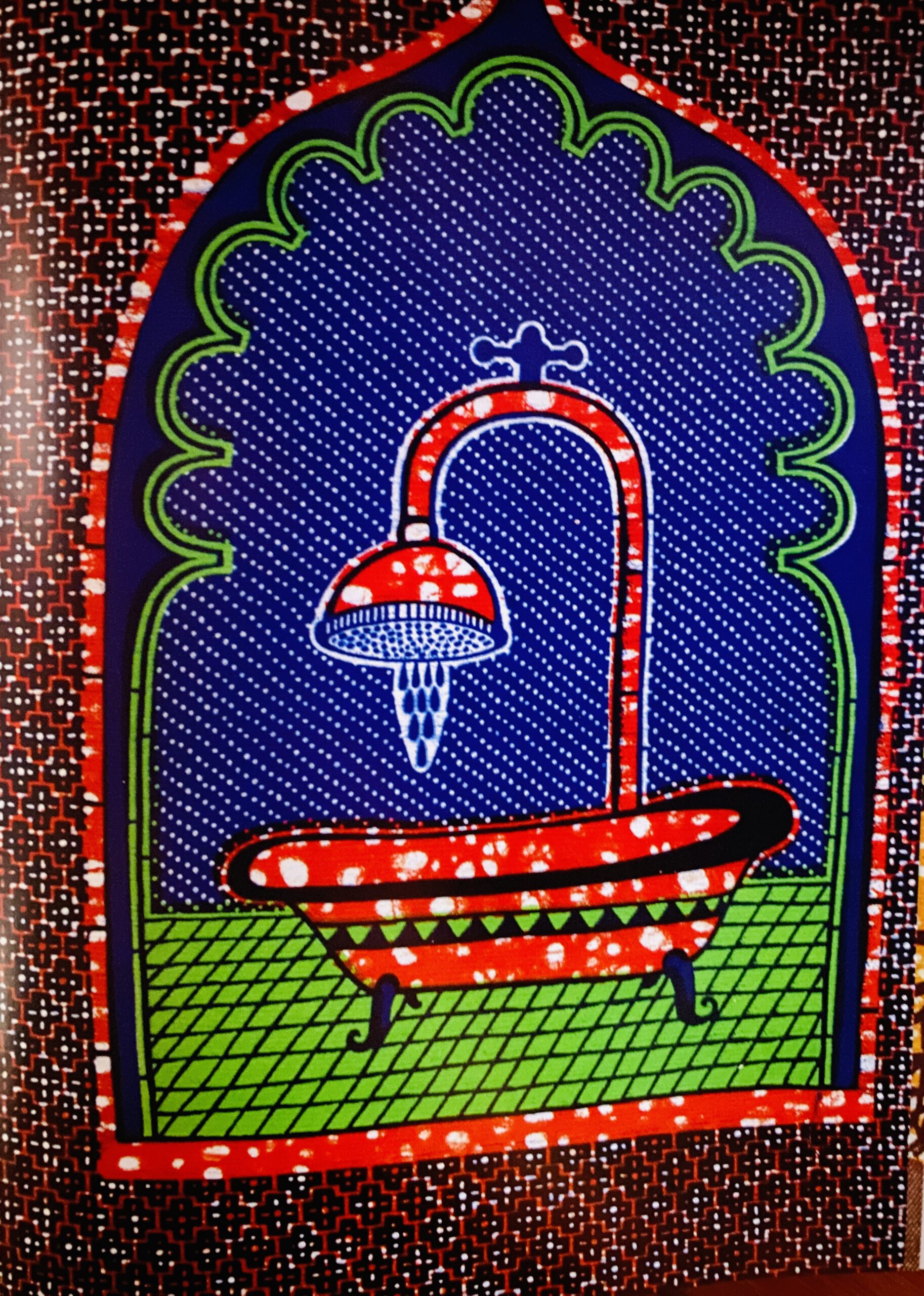—-Scroll down to read the German and French version—-
Is Africa really this colourful?
Anyone interested in African fashion often first thinks of the colourful cotton prints with large floral or graphic ornaments known as ‘wax’. What many people do not know is that the colourful wax prints are a colonial product, as only a very small proportion of them were and are produced on the African continent. The added value that results from industrial processing and creates jobs remains in the rich global North, similar to the export of cocoa, gold or cotton. For most wax prints, not even the raw material cotton comes from Africa.
Indonesian print conquers Africa
The first wax motifs were created by the end of the 19th century and in the first decade of the 20th century. The textile industry in Europe, especially in France and Great Britain, was looking for sales markets in their colonial areas of influence. The factories in Manchester and Nantes tried to compete with and even supplant the artisanal production of printed fabrics in India. A strategy that also appealed to some Dutch industrialists. The Netherlands controlled the Indonesian archipelago and endeavoured to mechanise the local batik technique in Holland in order to be able to sell the fabric series in Indonesia.
Using a machine called ‘La Javanaise’, cotton could be printed on both sides with wax. However, the experiments with this invention took so long that Holland no longer benefited from preferential tariffs, meaning that exports to the Indian Ocean were no longer rewarding. Unexpectedly, the African continent became the new market for the first wax fabrics. The idea of shipping the batik fabrics to the Atlantic coasts of Africa came from a Scottish merchant: Ebenezer Brown Fleming. He knew from Swiss missionaries that the first sewing machines had arrived in the Gold Coast – today’s Ghana. The demand for finer cotton for cutting and sewing increased accordingly, as traditional, hand-woven fabrics were predominantly available locally, which were more suitable for draping due to their thicker threads and firmer weave. In addition to exporting Dutch batik fabrics to Africa, Brown Fleming also developed suitable print patterns for the new clientele – with incredible success.

Classical Indigo Print, Credit: Vlisco
The Wax strikes the happy medium between exotic originality and well-known craftsmanship: it is an indigo-dyed fabric that has neither a left nor a right side, just like the local handmade fabrics. The ochre, brown and blue colours of the first synthetically dyed and printed batik fabrics come close to the local handmade fabrics. Their natural colour tones result from the vegetable decoctions of the kola and indigo trees. Traditional fabric production on the African continent was therefore originally organic and not garishly colourful. The bold combinations and rich colours of the wax print from Europe quickly began to catch on and the cliché that people in West and Central African countries have always worn colourful clothing persists to this day. African fashion only took on a colonial colour when wax was imported from Europe.
The motifs also changed with the history of the African continent, for example during the independence movements at the beginning of the 1960s, the devaluation of the CFA franc in 1994, which was harsh for the population, or the opening of the markets for the import of Chinese prints in 2004. It was only when the first industrial production facilities were established on the continent that the fabrics began to speak their own language with genuine messages for the people. With their names, the fabrics, called ‘pagnes’ in French-speaking countries, express intense emotions, anger or even sarcastic humour.

Credit: Wax, 500 tissus, Anne Grosfilley
Women traders become wealthy with fabric trade
After various African countries declared independence, a golden age began for some enterprising traders from Togo. The so-called ‘Nana Benz’ started to build up a small cross-border trade in fabrics in the 1950s. 20 years later, veritable empires have emerged. The fabric traders were among the first proud Mercedes owners and significantly influenced the designs of European manufacturers. They invented names for the various prints that expressed the hopes, worries and joys of their customers. Motif titles such as ‘If you go out, I’ll go out too’ or ‘Darling, don’t turn your back on me’ are among the classics of the time. The free port of Lomé became a hub for the wax trade. From there, the fabrics are distributed to Dakar, Kinshasa, Senegal and the Congo. In addition, the first production facility is set up in Abidjan: Uniwax, the future branch of Vlisco from the Netherlands, starts printing wax on the African continent. The wax boom comes to an abrupt end for Nana Benz with the devaluation of the CFA franc imposed by France in 1994 and the preceding strike in Togo.
In order to elude the market power of Nana Benz, whose exclusive rights to market certain motifs were less and less favourable to Vlisco, the Dutch company opened boutiques in the most important metropolises. In the Ivory Coast, ‘Wax made in Africa’ continues to develop well. A small group of designers is developing new motifs that are tailored to customers in every neighbourhood thanks to skilled tailors. The fabrics reflect the themes of the African metamorphosis: desertification, access to drinking water, the rapid growth of cities, traffic jams, mobile phones and increasing internet connections.

Credit: Wax, 500 tissus, Anne Grosfilley
In 2004, import restrictions on textiles to the African continent are suspended. Batches from India, Pakistan and China successively secure a market share of 95 per cent – a bitter economic blow for African manufacturers. Chinese products are subsidised by the state and offered at dumping prices. They are not genuine wax prints, but the fabrics are well copied. Given the prices, young female customers in Africa and the diaspora are not aware that the local industry is being brought to its knees. The British are relocating their production to Ghana with a design team in the UK. In Holland, Vlisco is looking for new strategies, as more and more wax classics are being imported cheaply in bulk. A new artistic director, Roger Gerards, provides a breath of fresh creative air. With large-scale motif compositions, he sets himself apart from the traditional small-scale, repetitive designs. This enabled Vlisco to successfully position itself in the luxury segment. Star designers such as Gaultier, Stella McCartney and Junya Watanabe develop their own wax models. Today, the Uniwax branch in Abidjan produces the majority of wax fabrics in Africa. The prints are now printed on natural-coloured cotton that is woven in Benin: After all, more than 100 years after the introduction of the first wax prints, a large part of the added value finally remains in Africa!
……………..
La mode africaine : le waxprint au banc d’essai colonial
Quelles sont les vraies couleurs de l’Afrique?
Lorsqu’on s’intéresse à la mode africaine, on a souvent en premier lieu à l’esprit les imprimés en coton aux couleurs vives et aux grands ornements floraux ou graphiques, appelés « wax ». Ce que beaucoup ignorent, c’est que les imprimés wax multicolores sont un produit colonial, car ils n’ont été et ne sont produits qu’en très petite partie sur le continent africain. La valeur ajoutée qui résulte du traitement industriel et qui crée des emplois reste, comme pour l’exportation du cacao, de l’or ou du coton, dans le riche Nord mondial. En effet, pour la plupart des waxprints, même la matière première, le coton, ne provient pas d’Afrique.
L’impression indonésienne à la conquête du continent africain
Les premiers motifs wax sont apparus vers la fin du 19e siècle et dans la première décennie du 20e siècle. L’industrie textile en Europe, notamment en France et en Grande-Bretagne, cherchait alors des débouchés dans ses zones d’influence coloniale. Les manufactures de Manchester et de Nantes ont tenté de concurrencer, voire de supplanter, la production artisanale de tissus imprimés en Inde. Une stratégie qui plaisait également à certains industriels hollandais. Les Pays-Bas contrôlaient l’archipel indonésien et s’efforçaient de mécaniser la technique locale du batik en Hollande afin de pouvoir vendre les séries de tissus en Indonésie.
Une machine appelée « La Javanaise » permettait d’imprimer le coton sur les deux faces avec de la cire. Cependant, l’expérimentation de cette invention a duré si longtemps que la Hollande ne bénéficiait plus de droits de douane préférentiels, si bien que l’exportation vers l’océan Indien n’était plus lucrative. De manière inattendue, le continent africain devint un nouveau débouché pour les premiers tissus en cire. L’idée d’expédier les batiks vers les côtes atlantiques de l’Afrique est venue d’un commerçant écossais : Ebenezer Brown Fleming. Il savait par des missionnaires suisses que les premières machines à coudre étaient arrivées sur la Côte d’Or – l’actuel Ghana. La demande de coton plus fin pour la coupe et la couture augmenta en conséquence, car sur place, il y avait surtout des tissus traditionnels tissés à la main, qui se prêtaient plutôt aux drapés grâce à leurs fils plus épais et à leur tissage plus solide. Outre l’exportation des tissus batik hollandais vers l’Afrique, Brown Fleming a également développé des motifs imprimés adaptés à cette nouvelle clientèle – avec un succès incroyable.

Classical Indigo Print, Credit: Vlisco
Le wax trouve exactement le juste milieu entre l’originalité exotique et l’artisanat connu: c’est un tissu teint à l’indigo qui n’a ni gauche ni droite, tout comme les tissus locaux faits main. Les tons ocres, bruns et bleus des premiers tissus batik teints et imprimés synthétiquement se rapprochent des tissus locaux faits à la main. Leurs teintes naturelles proviennent des décoctions végétales de cola et d’indigo. La production traditionnelle de tissus sur le continent africain était donc à l’origine biologique et non pas criarde de couleurs. Les combinaisons audacieuses et les tons saturés du waxprint importé d’Europe ont rapidement commencé à s’imposer et jusqu’à aujourd’hui, le cliché selon lequel les habitants des pays d’Afrique de l’Ouest et d’Afrique centrale auraient toujours porté des vêtements colorés a la vie dure. Ce n’est qu’avec le wax importé d’Europe que la mode africaine a pris des couleurs coloniales.
Avec l’histoire du continent africain, les motifs changent également, par exemple lors des luttes pour l’indépendance au début des années 60, de la dévaluation du franc CFA en 1994, qui a été dure pour la population, ou de l’ouverture des marchés à l’importation d’imprimés chinois en 2004. Ce n’est que lorsque les premiers sites de production industrielle ont vu le jour sur le continent que les tissus ont commencé à parler leur propre langage avec de véritables messages pour le peuple. Par leur nom, les tissus appelés « pagnes » dans les pays francophones expriment des émotions intenses, de la colère ou encore de l’humour sarcastique.

Credit: Wax, 500 tissus, Anne Grosfilley
Les commerçantes prospèrent grâce au commerce de tissus
Après les déclarations d’indépendance de divers États africains, un âge d’or commence pour quelques commerçantes togolaises entreprenantes. Celles que l’on appelle les « Nana Benz » ont commencé dans les années 50 à mettre en place un petit commerce transfrontalier de tissus. Vingt ans plus tard, de véritables empires ont ainsi vu le jour. Les marchandes de tissus comptaient parmi les premières fières propriétaires de Mercedes et ont largement influencé les designs des constructeurs européens. Elles inventèrent des noms pour les différents imprimés, dans lesquels s’exprimaient les espoirs, les soucis et la joie des clientes. Des titres de motifs comme « Si tu sors, je sors aussi » ou « Chérie, ne me tourne pas le dos » font partie des classiques de l’époque. Le port franc de Lomé devient la plaque tournante du commerce du wax. De là, les tissus sont distribués à Dakar, Kinshasa, au Sénégal ou au Congo. En outre, une première production voit le jour à Abidjan: Uniwax, la future filiale de Vlisco des Pays-Bas, se lance dans l’impression du wax sur le continent africain. Le boom du wax prend brutalement fin pour la Nana Benz avec la dévaluation du franc CFA imposée par la France en 1994 et la grève qui l’a précédée au Togo.
Pour se soustraire au pouvoir de marché de Nana Benz, dont les droits exclusifs de commercialisation de certains motifs conviennent de moins en moins à Vlisco, l’entreprise néerlandaise ouvre des boutiques dans les principales métropoles. En Côte d’Ivoire, le « Wax made in Africa » se développe bien. Un petit groupe de designers développe de nouveaux motifs qui sont taillés sur mesure pour la clientèle grâce à des tailleurs compétents dans chaque quartier. Sur les tissus se reflètent les thèmes de la métamorphose africaine : la désertification, l’accès à l’eau potable, la croissance rapide des villes, les embouteillages, la téléphonie mobile et la multiplication des connexions Internet.

Credit: Wax, 500 tissus, Anne Grosfilley
En 2004, les restrictions d’importation de textiles sur le continent africain sont suspendues. Des lots en provenance d’Inde, du Pakistan et de Chine s’assurent successivement une part de marché de 95 pour cent – un coup économique dur pour les manufactures africaines. Les produits chinois sont subventionnés par l’État et proposés à des prix de dumping. Il ne s’agit pas de véritables waxprints, mais les tissus sont bien copiés. Au vu des prix, les jeunes clientes d’Afrique et de la diaspora n’ont pas conscience que l’industrie nationale est mise à genoux. Les Britanniques délocalisent leur production au Ghana avec une équipe de designers en Grande-Bretagne. En Hollande, Vlisco cherche de nouvelles stratégies, car de plus en plus de classiques du wax sont importés en masse et à bas prix. Un nouveau directeur artistique, Roger Gerards, fait souffler un vent de créativité. Avec des compositions de motifs à grande échelle, il se démarque des designs traditionnellement petits et répétitifs. Vlisco parvient ainsi à se positionner avec succès dans le segment du luxe. Des designers vedettes comme Gaultier, Stella McCartney ou Junya Watanabe développent leurs propres modèles en cire. Aujourd’hui, la filiale d’Uniwax à Abidjan produit la majeure partie des tissus Wax en Afrique. Entre-temps, les motifs sont imprimés sur du coton de couleur naturelle, tissé au Bénin: Après tout, plus d’un siècle après l’introduction des premiers imprimés en cire, une grande partie de la valeur ajoutée reste enfin en Afrique!
……………..
Afrikanische Mode: Waxprint auf dem kolonialen Prüfstand
Wie bunt ist Afrika wirklich?
Wer sich für afrikanische Mode interessiert, hat oft zuallererst die farbenprächtigen Baumwolldrucke mit großen floralen oder grafischen Ornamenten vor Augen, genannt „Wax“. Was viele nicht wissen, die bunten Waxprints sind ein koloniales Produkt, denn sie wurden und werden nur zu einem sehr geringen Teil auf dem afrikanischen Kontinent produziert. Die Wertschöpfung, die aus der industriellen Verarbeitung entsteht und Arbeitsplätze schafft, bleibt ähnlich wie beim Export von Kakao, Gold oder Baumwolle im reichen globalen Norden hängen. Denn für die meisten Waxprints stammt nicht einmal der Rohstoff Baumwolle aus Afrika.
Indonesischer Druck erobert den afrikanischen Kontinent
Die ersten Wax-Motive sind gegen Ende des 19. Jahrhunderts und im ersten Jahrzehnt des 20. Jahrhunderts entstanden. Die Textilindustrie in Europa, besonders in Frankreich und Großbritannien, suchte damals nach Absatzmärkten in ihren kolonialen Einflussgebieten. Die Manufakturen in Manchester und Nantes versuchten mit der handwerklichen Herstellung von bedruckten Stoffen in Indien zu konkurrieren und diese sogar zu verdrängen. Eine Strategie, die auch einige holländischen Industriellen gefiel. Die Niederlande kontrollierten das indonesische Archipel und bemühten sich, die lokale Batiktechnik in Holland zu mechanisieren, um die Stoffserien in Indonesien verkaufen zu können.
Mit einer Maschine namens „La Javanaise“ ließ sich Baumwolle doppelseitig mit Wachs bedrucken. Allerdings dauerten die Experimente mit dieser Erfindung so lange, dass Holland nicht mehr von Preferenzzollsätzen profitierte, so dass der Export in Richtung indischem Ozean nicht mehr lukrativ war. Unerwarteterweise wurde der afrikanische Kontinent zum neuen Absatzgebiet für die ersten Waxstoffe. Die Idee, die Batikstoffe an die atlantischen Küsten von Afrika zu verschiffen, kam von einem schottischen Händler: Ebenezer Brown Fleming. Er wusste von Schweizer Missionaren, dass in der Goldküste – das heutige Ghana – die ersten Nähmaschinen angekommen waren. Die Nachfrage nach feinerer Baumwolle zum Zuschneiden und Nähen stieg entsprechend, denn vor Ort gab es vorwiegend traditionelle, handgewebte Stoffe, die sich durch ihre dickeren Fäden und die festere Webart eher für Drapierungen eigneten. Neben dem Export der holländischen Batikstoffe nach Afrika, entwickelte Brown Fleming außerdem die passenden Druckmuster für die neue Kundschaft – mit unglaublichem Erfolg.

Classical Indigo Print, Credit: Vlisco
Der Wax trifft genau die goldene Mitte zwischen exotischer Originalität und bekannter Handwerkskunst: Es ist ein mit Indigo gefärbter Stoff, der weder eine linke noch eine rechte Seite hat, genau wie die lokalen handgefertigten Stoffe. Die Ocker-, Braun- und Blautöne der ersten synthetisch gefärbten und bedruckten Batikstoffe kommen den lokalen handgefertigten Stoffen nahe. Ihre natürlichen Farbtöne stammen aus den pflanzlichen Abkochungen der Kolabäume und des Indigos. Die traditionelle Stoffproduktion auf dem afrikanischen Kontinent war also ursprünglich biologisch und nicht schreiend bunt. Die gewagten Kombinationen und satten Farbtöne des Waxprint aus Europa begannen sich schnell durchzusetzen und bis heute hält sich das Klischee, die Menschen in den west- und zentralafrikanischen Ländern hätten schon immer bunte Kleidung getragen, hartnäckig. Erst mit dem aus Europa importierten Wax hat die afrikanische Mode koloniale Farbe bekommen.
Mit der Geschichte des afrikanischen Kontinents verändern sich auch die Motive, zum Beispiel während der Unabhängigkeitsbestrebungen Anfang der 60er Jahre, der für die Bevölkerung herben Entwertung des Franc CFA 1994, oder der Öffnung der Märkte für den Import chinesischer Drucke 2004. Erst als die ersten industriellen Produktionsstätten auf dem Kontinent entstehen, beginnen die Stoffe, ihre ureigene Sprache mit echten Botschaften für das Volk zu sprechen. Mit ihren Namen drücken die im französischsprachigen Ländern „Pagnes“ genannten Stoffe intensive Emotionen, Wut oder auch sarkastischen Humor aus.

Credit: Wax, 500 tissus, Anne Grosfilley
Händlerinnen kommen mit Stoffhandel zu Wohlstand
Nach den Unabhängigkeitserklärungen diverser afrikanischer Staaten beginnt für einige geschäftstüchtige Händlerinnen aus Togo ein goldenes Zeitalter. Die sogenannten „Nana Benz“ haben in den 50er Jahren begonnen, einen kleinen grenzüberschreitenden Handel mit Stoffen aufzubauen. 20 Jahre später sind so regelrechte Imperien entstanden. Die Stoffhändlerinnen zählten zu den ersten stolzen Mercedes-Besitzerinnen und beeinflussten die Designs der europäischen Hersteller maßgeblich. Sie erfanden Namen für die unterschiedlichen Prints, in denen die Hoffungen, Sorgen und die Freude der Kundinnen Ausdruck fanden. Motivtitel wie, „Wenn Du ausgehst, gehe ich auch aus“ oder „Liebling, dreh mir nicht den Rücken zu“ gehören zu den Klassikern dieser Zeit. Der Freihafen von Lomé wird zur Drehscheibe für den Wax-Handel. Von dort aus werden die Stoffe nach Dakar, Kinshasa, in den Senegal oder den Congo vertrieben. Darüber hinaus entsteht eine erste Produktion in Abidjan: Uniwax, die zukünftige Filiale von Vlisco aus den Niederlanden startet mit dem Waxdruck auf dem afrikanischen Kontinent. Der Wax-Boom nimmt für die Nana Benz mit der von Frankreich verordneten Entwertung des Franc CFA im Jahr 1994 und dem vorausgegangenen Streik in Togo ein jähes Ende.
Um sich der Marktmacht der Nana Benz zu entziehen, deren Exklusivrechte bei der Vermarktung bestimmter Motive Vlisco immer weniger zusagen, eröffnet das niederländische Unternehmen in den wichtigsten Metropolen Boutiquen. In der Elfenbeinküste entwickelt sich der „Wax made in Africa“ gut weiter. Eine kleine Designergruppe entwickelt neue Motive, die der Kundschaft dank fähiger Schneider in jedem Stadtviertel auf den Leib geschneidert werden. Auf den Stoffen spiegeln sich die Themen der afrikanischen Metamorphose wider: die Versteppung, der Zugang zu Trinkwasser, das schnelle Wachstum der Städte, Staus, Mobilfunk und die zunehmenden Internet-Verbindungen.

Credit: Wax, 500 tissus, Anne Grosfilley
Im Jahr 2004 werden die Einfuhrbeschränkungen für Textilien auf den afrikanischen Kontinent ausgesetzt. Chargen aus Indien, Pakistan und China sichern sich sukzessive einen Marktanteil von 95 Prozent – ein herber ökonomischer Schlag für die afrikanischen Manufakturen. Die chinesischen Produkte sind staatlich subventioniert und werden zu Dumpingpreisen angeboten. Es handelt sich dabei nicht um echte Waxprints, aber die Stoffe sind gut kopiert. Den jungen Kundinnen in Afrika und der Diaspora fehlt angesichts der Preise das Bewusstsein dafür, dass die heimische Industrie in die Knie gezwungen wird. Die Briten verlegen ihre Produktion nach Ghana mit einem Designteam in Großbritannien. In Holland sucht Vlisco nach neuen Strategien, denn immer mehr Wax-Klassiker werden in Massen billig importiert. Ein neuer künstlerischer Direktor, Roger Gerards, sorgt für frischen kreativen Wind. Mit großflächigen Motivkompositionen setzt er sich von den traditionell kleinteiligen, sich wiederholenden Designs ab. Vlisco gelingt es so, sich erfolgreich im Luxussegment zu positionieren. Stardesigner wie Gaultier, Stella McCartney oder Junya Watanabe entwickeln eigene Wax-Modelle. Heute produziert die Uniwax-Filiale in Abidjan das Gros der Wax-Stoffe in Afrika. Mittlerweile werden die Prints auf naturfarbene Baumwolle gedruckt, die in Benin gewebt wird: Immerhin bleibt so mehr als 100 Jahre nach der Einführung der ersten Waxprints endlich ein Großteil der Wertschöpfung in Afrika!
……………..
